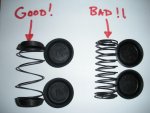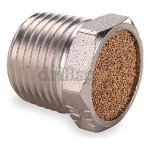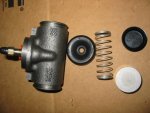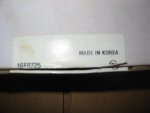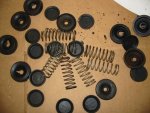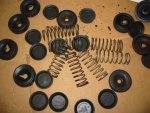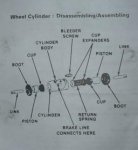What could be a more common event? Go to GL to pick up your new deuce, and its brake pedal has no resistance all the way to the floor. It happened to me, and I would bet it has happened to more than a few of you.
So, you pull out your patented SS Garden Sprayer Brake Bleeder, bleed the brakes, and everything seems fine for the trip home. Everything seems fine for the next several weeks, or maybe even months... until you let your deuce sit unused for an extended period of time, and then once again you step on the pedal and find your brakes are deadlined. Bother!
When it happened to me, and I got tired of bleeding the brakes, I tore down the offending axle, and tried to figure out why:
1) the wheel cylinder was brand new... shiny even.
2) the rubber parts were USA made, and were perfect.
3) the boots were USA made, and perfect too.
But in spite of everything looking great, the boots were full of leaked DOT 5.
On inspecting the parts from the bad wheel cylinder, one very big thing became evident immediately: The spring was totally wrong for a brake wheel cylinder. It was square shouldered, and didn't have expander coils on the ends to expand out the piston cups. I have attached a photo to show what I mean.
Here is what I think happened:
As the deuce reached its end-of-line with the active units, the DOD started to get more aggressive in beating down the prices on parts needed to keep the trucks running. Somewhere along the way, they found a vendor of loaded wheel cylinders that was willing to shave a few cents to make a cheaper unit. They substituted common square shouldered springs for the more complicated expander springs that should be in wheel cylinders... probably betting that nobody important would take a loaded wheel cylinder apart and look. I'd say they won the bet.
Why does it matter?
Most of the time it doesn't. If the truck is used regularly, the brakes will stay pumped up, and the DOT5 will keep the piston cup expanded just from regular use. But if the truck sits on the lot for months at a time without use, a different problem starts to show up.
The master cylinder on most deuces has a one-way vent (bobble head) that lets excess air pressure out of the reservoir, but won't let water (or air) back in. This is a good idea if the deuce ever happens to ford 3 feet of water, but otherwise, maybe not so much so.
When air gets hot, it expands, and so it happens in the reservoir of the deuce master cylinder. The pressure caused by this expansion makes the one-way air vent burp the air out. But when it gets cold again, the air contracts, and sucks on the one-way air vent. Because the vent is one-way, the suction cannot be relieved through the vent, so it is reflected through the DOT5, and draws in the wheel cylinders instead.
Wheel cylinders are by design, great at sealing against pressure from the fluid side... the hydraulic pressure pushes the lip on the piston cup tight against the cylinder wall.... But suction is the wrong way. Absent the expander coils, the piston cup lip deflects inward, and air passes into the wheel cylinder. When that happens, the highly compressible air lets your pedal go to the floor... once again.
Any comments?
-Chuck
So, you pull out your patented SS Garden Sprayer Brake Bleeder, bleed the brakes, and everything seems fine for the trip home. Everything seems fine for the next several weeks, or maybe even months... until you let your deuce sit unused for an extended period of time, and then once again you step on the pedal and find your brakes are deadlined. Bother!
When it happened to me, and I got tired of bleeding the brakes, I tore down the offending axle, and tried to figure out why:
1) the wheel cylinder was brand new... shiny even.
2) the rubber parts were USA made, and were perfect.
3) the boots were USA made, and perfect too.
But in spite of everything looking great, the boots were full of leaked DOT 5.
On inspecting the parts from the bad wheel cylinder, one very big thing became evident immediately: The spring was totally wrong for a brake wheel cylinder. It was square shouldered, and didn't have expander coils on the ends to expand out the piston cups. I have attached a photo to show what I mean.
Here is what I think happened:
As the deuce reached its end-of-line with the active units, the DOD started to get more aggressive in beating down the prices on parts needed to keep the trucks running. Somewhere along the way, they found a vendor of loaded wheel cylinders that was willing to shave a few cents to make a cheaper unit. They substituted common square shouldered springs for the more complicated expander springs that should be in wheel cylinders... probably betting that nobody important would take a loaded wheel cylinder apart and look. I'd say they won the bet.
Why does it matter?
Most of the time it doesn't. If the truck is used regularly, the brakes will stay pumped up, and the DOT5 will keep the piston cup expanded just from regular use. But if the truck sits on the lot for months at a time without use, a different problem starts to show up.
The master cylinder on most deuces has a one-way vent (bobble head) that lets excess air pressure out of the reservoir, but won't let water (or air) back in. This is a good idea if the deuce ever happens to ford 3 feet of water, but otherwise, maybe not so much so.
When air gets hot, it expands, and so it happens in the reservoir of the deuce master cylinder. The pressure caused by this expansion makes the one-way air vent burp the air out. But when it gets cold again, the air contracts, and sucks on the one-way air vent. Because the vent is one-way, the suction cannot be relieved through the vent, so it is reflected through the DOT5, and draws in the wheel cylinders instead.
Wheel cylinders are by design, great at sealing against pressure from the fluid side... the hydraulic pressure pushes the lip on the piston cup tight against the cylinder wall.... But suction is the wrong way. Absent the expander coils, the piston cup lip deflects inward, and air passes into the wheel cylinder. When that happens, the highly compressible air lets your pedal go to the floor... once again.
Any comments?
-Chuck
Attachments
-
45.7 KB Views: 338



